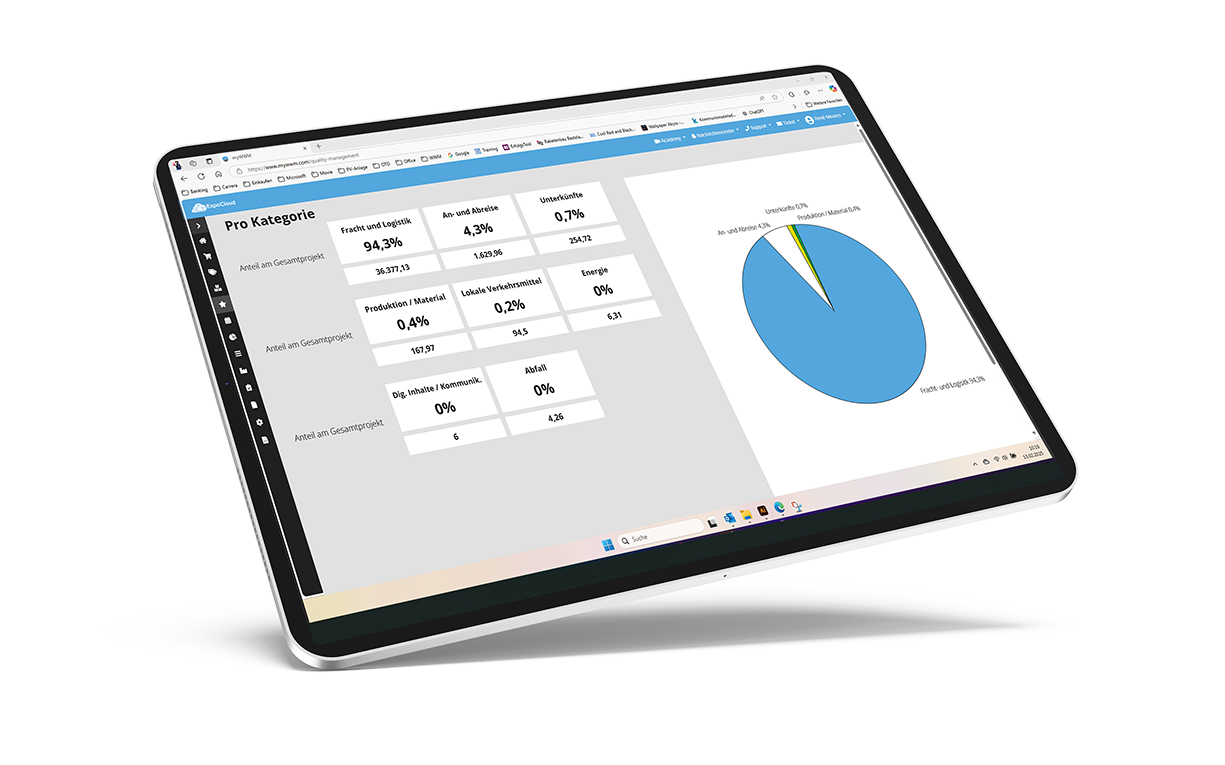CO2 calculator for more sustainability
Calculation of the CO2 footprint for exhibition stands
- Services
- Consulting
- CO2 Calculation
In today's world, where sustainability and environmental protection are becoming increasingly important, calculating the carbon footprint of an exhibition stand is a crucial step. Here are some reasons why this is so important:
1. Environmental awareness and climate protection
Reducing CO2 emissions is a significant contribution to climate protection. By calculating the carbon footprint of an exhibition stand, companies can better understand their environmental impact and take measures to reduce it. This can be achieved through the selection of sustainable materials, the optimisation of transport routes and the use of energy-efficient technologies.

2. Legal requirements
Many countries and regions have already introduced strict environmental regulations or are planning to do so in the near future. Calculating the carbon footprint helps companies to comply with these regulations and prepare for future regulations. This can also help to avoid potential penalties and legal problems.

3. Competitive advantage
An environmentally conscious behaviour can represent a considerable competitive advantage. Customers and business partners are increasingly favouring companies that are actively committed to environmental protection. An exhibition stand with a low carbon footprint can improve a company's image and make it more attractive to environmentally conscious customers.

4. Cost savings
Reducing CO2 emissions often goes hand in hand with cost savings. By optimising resources and energy consumption, companies can not only reduce their environmental footprint, but also cut operating costs. This can lead to considerable savings in the long term.

5. Responsibility and transparency
Calculating and disclosing the carbon footprint shows that a company takes responsibility and acts transparently. This strengthens the trust of customers and partners and promotes a positive corporate reputation. Transparency in environmental matters is increasingly seen as a sign of integrity and a sense of responsibility.

What solutions does WWM offer for calculating the
the CO2 footprint of trade fairs & events?
A: Customised calculation
We calculate the total CO2 footprint of your event based on the NZCE methodology. We take the following elements into account:
- Production & materials
- Freight & logistics
- Hospitality & catering
- Travel to and from the event
- Local logistics
- Overnight stays
- Energy
- Waste & disposal
- Digital services & communication
The nature of the various elements depends on the type and scope of the event.
B: Automatic calculation
For customers using the Expocloud ERM solution, there is the option of automatic CO2 calculation based on the NZCE methodology for all events and visualisation in a dashboard.

The Enterprise version is a prerequisite for fully automatic calculation.
Excursus: What is the NZCE Methodology?
The NZCE Measurement Methodology provides comprehensive guidance on measuring and quantifying greenhouse gas (GHG) emissions at events. It was developed by the Net Zero Carbon Events (NZCE) initiative to help event organisers reduce their emissions and achieve net zero emissions by 2050.
Main contents:
- Introduction and necessity: The methodology is necessary to measure and reduce the complex emissions of events. It is based on the GHG Product Life Cycle Accounting and Reporting Standard.
- Setting boundaries: Defining the temporal and spatial boundaries of emissions, including the nine identified emission sources: Production and Materials, Freight and Logistics, Food and Beverage, Travel to and from Destination, Local Transport, Accommodation, Energy, Waste and Digital Content and Communications.
- Methodological approaches: Introduction of a three-tier system for quantifying emissions (basic, intermediate, advanced) and selection of emission factors.
- Measurement of event emissions: Detailed guidance on how to measure emissions in the nine categories, including primary data to be collected, formulas to convert to emissions and sources of emission factors.
- Key metrics at event level: Suggestions for metrics to report on event emissions.
- Extrapolation and gap filling: guidance on extrapolating emissions data for multiple events and filling data gaps.
- Baseline setting considerations: Approaches to setting baselines and targets for emissions reductions.
Further information can be found at: Net Zero Carbon Events | Net Zero Carbon Events


